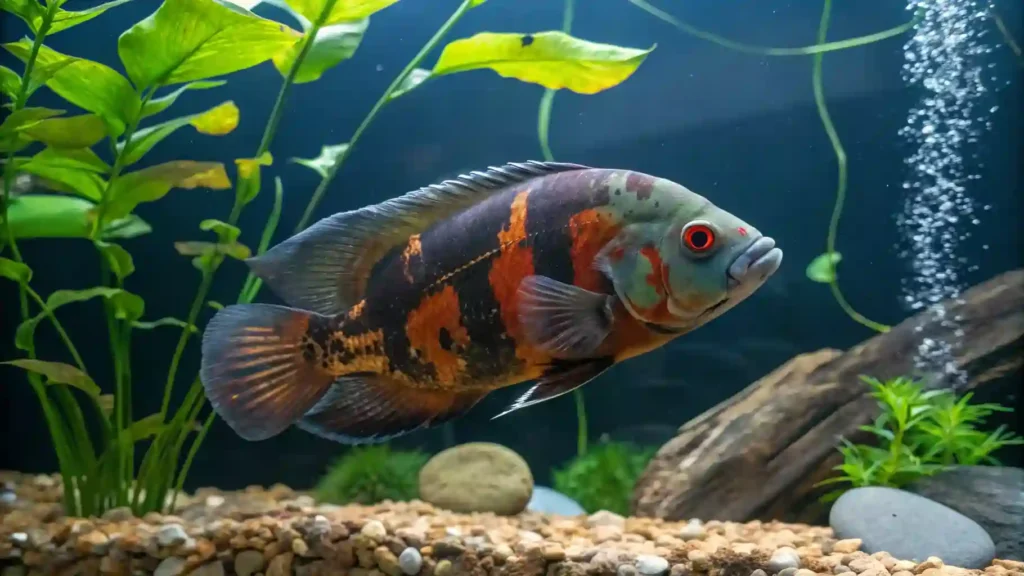Oscar Fish Care, Food & Health Tips: A Beginner’s Guide

Welcome to the ultimate beginner’s guide for Oscar fish care! These colorful, lively fish from South America are a favorite for aquarium lovers because of their bold personalities and striking looks. Oscars, also called Astronotus ocellatus, grow big, act smart, and can live a long time, but they need the right care to stay healthy. This guide will walk you through everything you need to know about setting up a tank, feeding, keeping them healthy, understanding their behavior, choosing tankmates, and even breeding them. Whether you’re new to fishkeeping or want to learn more, this article will help you create a happy home for your Oscars.
Why Oscars Are Special
Oscars stand out in any aquarium. Here’s why they’re worth the effort:
- Fun Behavior: They act like pets, sometimes following you or playing with objects in the tank.
- Bright Colors: From tiger stripes to red or black patterns, they make your tank pop.
- Long Life: With good care, they can live 10-15 years, becoming a true companion.
- Big Size: They grow to 12-16 inches, so they need lots of space.
Because they get so big and can be a bit bossy, Oscars aren’t the easiest fish for beginners, but with the right setup, anyone can care for them. Let’s start with the most important part: their home.
Expand Your Knowledge Here: Types of Oscar Fish – A Complete Guide
Setting Up the Perfect Tank
A great tank setup is the first step to happy fish. Oscars make a lot of waste and need room to swim, so their tank needs to be just right. For a full step-by-step plan, check our detailed tank setup guide (replace with your actual tank setup article URL).
Choosing the Right Tank Size
Oscars need a big tank because they grow large and love to move. Here’s what to consider:
- Single Fish: A 55-gallon tank is the minimum, but 75-100 gallons is better for comfort.
- Two or More: Pairs or groups need at least 125 gallons to avoid fights.
- Space for Decor: Leave room for hiding spots and swimming areas.
A bigger tank also helps keep water clean, which is super important for these messy fish.
Filtration and Water Flow
Oscars produce a lot of waste, so you need a strong filter to keep the water clear:
- Filter Type: A canister or external filter works best. Choose one rated for 6-8 times the tank’s volume per hour.
- Maintenance: Clean the filter monthly to keep it working well.
- Water Movement: Oscars like gentle water flow, so adjust the filter outlet to avoid strong currents.
Good filtration prevents health problems and makes your tank easier to manage.
Heating and Temperature
These fish come from warm waters, so a heater is a must:
- Temperature Range: Keep water between 74-81°F (23-27°C).
- Heater Size: Use a heater with 5 watts per gallon (e.g., 250W for a 50-gallon tank).
- Thermometer: Check the temperature daily to catch any changes.
Sudden temperature drops can stress your fish, so invest in a reliable heater.
Substrate and Decorations
Oscars love to dig and explore, so choose tank decor carefully:
- Substrate: Gravel or sand is fine, but a bare-bottom tank is easier to clean.
- Hiding Spots: Add rocks, driftwood, or caves for them to hide in.
- Safety: Use smooth decorations to avoid scratches or injuries.
Avoid plastic plants, as Oscars might chew them. Sturdy, natural decor works best.
Water Quality Basics
Clean water is key to keeping your fish healthy. Here are the ideal water conditions:
| Parameter | Ideal Range |
|---|---|
| pH | 6.5-7.5 |
| Hardness | 5-20 dGH |
| Ammonia | 0 ppm |
| Nitrite | 0 ppm |
| Nitrate | Below 20 ppm |
- Water Changes: Replace 25-30% of the water every week.
- Testing: Use a test kit to check water weekly.
- Conditioner: Add water conditioner to remove chlorine from tap water.
Stable water conditions prevent stress and illness, so stay consistent.
Tip: A bare-bottom tank makes it easier to spot leftover food or waste during cleaning.
Feeding Your Oscars
Feeding your fish the right foods keeps them colorful and active. Oscars are carnivores with big appetites, so variety is important.
Best Foods for Oscars
A mix of foods ensures your fish get all the nutrients they need:
- Pellets: Choose high-protein (40-50%) sinking pellets made for cichlids. These are their main food.
- Frozen Foods: Bloodworms, brine shrimp, or krill add variety as treats.
- Live Foods: Earthworms or crickets can be fed once or twice a month.
- Vegetables: Blanched spinach, zucchini, or peas provide fiber.
Always choose high-quality foods to avoid health issues.
Feeding Schedule
Oscars don’t need much food, but they love to eat. Follow these tips:
- Frequency: Feed adults 1-2 times daily, giving what they can eat in 2-3 minutes.
- Portion Control: Overfeeding can make them fat or dirty the tank.
- Preparation: Soak dry pellets in tank water to make them easier to digest.
- Variety: Change up foods weekly to keep them interested.
Warning: Don’t feed human foods like bread, chicken, or rice. These can upset their stomachs.
Avoiding Common Feeding Mistakes
Beginners often make feeding errors that harm their fish:
- Too Much Food: Extra food sinks and pollutes the tank. Feed small amounts.
- Low-Quality Food: Cheap pellets lack nutrients. Spend a bit more for good brands.
- Too Many Live Foods: Feeder fish can carry diseases, so use them sparingly.
A balanced diet keeps your Oscars growing strong and looking bright.

Keeping Oscars Healthy
Healthy fish are active and colorful. Watching for signs of trouble and maintaining good tank conditions can prevent most problems.
Common Health Issues
Here are three common problems and how to handle them:
1. Hole-in-the-Head Disease (HITH)
- What It Looks Like: Small pits or sores on the head or sides.
- Why It Happens: Bad water quality, stress, or poor diet.
- Prevention: Keep water clean, feed a mix of foods, and give them enough space.
- Treatment: Do extra water changes, add aquarium salt (1 tsp per gallon), and ask a vet for medicated food if it’s bad.
2. Ich (White Spot Disease)
- What It Looks Like: Tiny white dots on fins or body, rubbing against objects.
- Why It Happens: Parasites, often from temperature changes or new fish.
- Prevention: Keep water stable and quarantine new fish for 2 weeks.
- Treatment: Slowly raise the tank to 82°F (28°C) and use ich medicine.
3. Fin Rot
- What It Looks Like: Fins look torn or discolored.
- Why It Happens: Bacteria from dirty water or cuts.
- Prevention: Clean the tank regularly and use smooth decor.
- Treatment: Improve water quality and add an antibacterial treatment.
Health Monitoring Tips
Catching problems early makes them easier to fix:
- Daily Checks: Look for changes in eating, swimming, or color.
- Quarantine Tank: Have a 20-gallon tank ready for sick or new fish.
- Stress Signals: Hiding, dull colors, or fast breathing mean something’s wrong.
Regular care keeps your fish in top shape.
Understanding Oscar Fish Behavior
Oscars are known for their unique personalities, which makes them fun to watch but tricky to manage. Knowing how they act helps you care for them better.
Social and Interactive Nature
These fish are smart and curious:
- Owner Recognition: They may swim to the glass when they see you.
- Playful Actions: Some nudge decorations or chase floating objects.
- Territorial Instincts: They can get bossy, especially in small tanks.
Give them space and things to explore to keep them happy.
Signs of a Happy Oscar Fish
A healthy, content fish shows these behaviors:
- Active Swimming: They explore the tank and don’t hide all the time.
- Bright Colors: Vivid patterns mean they’re feeling good.
- Good Appetite: Eager eating is a great sign.
If your fish seems shy or dull, check the tank conditions or tankmates.
Handling Aggression
Oscars can be aggressive, especially with other fish or during feeding:
- Tank Size: A bigger tank reduces fights over space.
- Hiding Spots: Caves or plants give them places to retreat.
- Feeding Strategy: Feed them separately if they fight over food.
Understanding their behavior helps you create a peaceful tank.
Choosing Tankmates for Oscars Fish
Oscars are territorial, so picking the right tankmates is crucial to avoid stress or fights.
Good Tankmates
Choose fish that can handle Oscars’ size and attitude:
- Silver Dollars: Peaceful and fast, they get along well.
- Plecos: Bottom-dwellers that clean up waste and stay out of the way.
- Jack Dempseys: Similar-sized cichlids that can hold their own.
Pick fish of similar size to avoid bullying.
Bad Tankmates
Some fish don’t mix well with Oscars:
- Small Fish: Guppies or tetras might get eaten.
- Slow Fish: Slow swimmers can’t escape an Oscar’s chase.
- Aggressive Fish: Too much aggression causes stress for everyone.
Always introduce new fish slowly and watch for fights.
Tips for Adding Tankmates
- Quarantine First: Keep new fish in a separate tank for 2 weeks to check for diseases.
- Rearrange Decor: Change the tank layout when adding new fish to reduce territorial claims.
- Monitor Closely: Watch for chasing or nipping in the first few days.
A well-planned tank keeps everyone happy.
Breeding Oscars: A Beginner’s Overview
Breeding Oscars can be exciting but takes extra effort. Here’s a simple guide to get started.
Preparing for Breeding
Oscars breed when conditions are right:
- Mature Pair: They need to be at least 1-2 years old and 8-10 inches long.
- Tank Size: A 100-gallon tank or larger is best for a breeding pair.
- Flat Surface: Provide a smooth rock or slate for egg-laying.
Good water quality and a healthy diet encourage breeding.
Breeding Behavior
Oscars show clear signs when they’re ready to breed:
- Pair Bonding: They swim together and clean a surface for eggs.
- Color Changes: Colors may get brighter, especially in males.
- Egg Laying: Females lay 1,000-2,000 eggs, which males fertilize.
Watch for aggression, as pairs can get protective.
Caring for Fry
If breeding works, you’ll need to care for the babies:
- Separate Tank: Move eggs or fry to a 20-gallon tank to protect them from being eaten.
- Feeding Fry: Offer baby brine shrimp or crushed pellets several times a day.
- Water Quality: Keep water extra clean, as fry are sensitive.
Breeding is a big step, so only try it if you’re ready for the work.
Challenges of Breeding
Breeding isn’t always easy:
- Aggression: Parents may fight or eat eggs if stressed.
- Space Needs: Fry need lots of room as they grow.
- Time Commitment: Raising fry takes daily care for months.
Start with caring for adult Oscars before diving into breeding.
Daily and Weekly Care Routine
A regular routine keeps your fish healthy and your tank clean. Here’s a simple schedule:
Daily Tasks
- Feed: Give food 1-2 times, removing uneaten bits after 3 minutes.
- Check Behavior: Look for active swimming and bright colors.
- Monitor Equipment: Ensure the heater and filter are working.
Weekly Tasks
- Water Change: Replace 25-30% of the water with conditioned tap water.
- Test Water: Check pH, ammonia, and nitrate levels.
- Clean Glass: Wipe algae from the tank walls for a clear view.
Monthly Tasks
- Filter Maintenance: Rinse filter media in tank water to keep it clean.
- Check Decor: Make sure rocks or caves are secure.
- Inspect Health: Look closely for any sores or spots on your fish.
Sticking to a routine makes fishkeeping easier and more fun.
Enrichment for Oscars
Oscars are smart and get bored easily. Adding enrichment keeps them active and happy.
Ideas for Enrichment
- Rearrange Decor: Move rocks or driftwood monthly to create new spaces to explore.
- Floating Toys: Add a ping-pong ball or floating plant for them to nudge.
- Mirror Play: Place a mirror outside the tank for a few minutes to spark curiosity.
Benefits of Enrichment
- Reduces Stress: Keeps them engaged and less aggressive.
- Boosts Activity: Encourages swimming and exploration.
- Enhances Colors: Happy fish often show brighter colors.
Try different ideas to see what your fish enjoy most.
Common Beginner Mistakes to Avoid
New fishkeepers often make errors that can harm their Oscars. Here’s what to watch out for:
- Small Tank: A tank under 55 gallons stresses fish and dirties water fast.
- Overfeeding: Too much food causes obesity and tank pollution.
- Poor Water Quality: Skipping water changes leads to health issues.
- Wrong Tankmates: Small or aggressive fish cause fights or get eaten.
Learning these mistakes early helps you avoid problems.
FAQs About Oscar Fish Care
Q: How fast do Oscars grow?
A: They grow about 1 inch per month in their first year, reaching 10-12 inches as adults.
Q: Can Oscars live alone?
A: Yes, they’re happy alone but can live with compatible tankmates in a big tank.
Q: What if my Oscar stops eating?
A: Check water quality, temperature, or stress from tankmates. Offer different foods to spark interest.
Q: How do I know if my fish is male or female?
A: It’s hard to tell until breeding, but females may have a rounder belly, and males may show brighter colors.
Q: Are Oscars hard to care for?
A: They need a big tank and regular care, but they’re manageable for dedicated beginners.
Troubleshooting Common Problems
If something goes wrong, here’s how to fix it:
- Cloudy Water: Check the filter and do a water change. Overfeeding might be the cause.
- Fish Hiding: Look for stress from bad water, small tanks, or aggressive tankmates.
- Faded Colors: Test water quality and ensure a varied diet.
- Fighting: Add hiding spots or separate aggressive fish.
Quick action keeps small issues from becoming big problems.
Long-Term Care Tips
To keep your Oscars thriving for years, follow these tips:
- Upgrade Tanks: As they grow, move to a larger tank if needed.
- Stay Consistent: Keep up with water changes and feeding schedules.
- Learn Their Personality: Each fish is unique, so watch how they act to spot changes.
- Join Communities: Online forums or local aquarium clubs offer great advice.
Long-term care builds a strong bond with your fish.
Conclusion
Caring for Oscar fish is a fun and rewarding journey for beginners who are ready to put in the effort. From setting up a spacious tank to feeding a balanced diet and watching for health issues, this guide covers everything you need to know. Start with our tank setup guide (replace with your actual URL) to get the basics right, and use this article to learn about feeding, health, behavior, and more. With the right care, your Oscars will bring color and personality to your home for years.
Expand Your Knowledge Here: Aquascaping for Oscar Fish – Tank Setup Ideas
Lina Gillmore
Lina Gillmore is a freshwater fish enthusiast and writer, known for her insightful articles on aquarium care and aquatic life. Her work blends science with a passion for nature.
